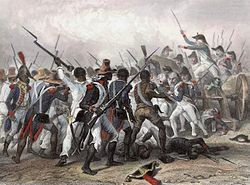| Part of a series on |
| North American slave revolts |
|---|
 Attack and capture of the Crête-à-Pierrot (Combat et prise de la Crête-à-Pierrot, March 1802) in the Haitian Revolution by Auguste Raffet, engraving by Ernest Hébert Attack and capture of the Crête-à-Pierrot (Combat et prise de la Crête-à-Pierrot, March 1802) in the Haitian Revolution by Auguste Raffet, engraving by Ernest Hébert |
| Context |
|
Before 1700
(Spanish Florida, victorious)
(Real Audiencia of Panama, New Spain, suppressed)
(Veracruz, New Spain, victorious)
(New Spain, suppressed)
(New Spain, suppressed)
|
|
18th century
(British Province of New York, suppressed)
(British Jamaica, victorious)
(British Chesapeake Colonies, suppressed)
(Louisiana, New France, suppressed) (Danish Saint John, suppressed)
(British Province of South Carolina, suppressed)
(British Province of New York, suppressed)
(British Jamaica, suppressed) (British Montserrat, suppressed)
(British Bahamas, suppressed)
(Louisiana, New Spain, suppressed) (Louisiana, New Spain, suppressed) (Dutch Curaçao, suppressed)
|
19th century
(Virginia, suppressed)
(St. Simons Island, Georgia, victorious)
(Virginia, suppressed) (Territory of Orleans, suppressed)
(Spanish Cuba, suppressed)
(Virginia, suppressed)
(British Barbados, suppressed)
(South Carolina, suppressed) (Cuba, suppressed) (Virginia, suppressed)
(British Jamaica, suppressed)
(off the Cuban coast, victorious)
(off the Southern U.S. coast, victorious) (Indian Territory, suppressed)
(Spanish Cuba, suppressed) (South Carolina, suppressed)
|
| Notable leaders |
On June 25, 1791, a group of enslaved Mina gathered on the estate of the widow Robillard in New Roads, Pointe Coupée Parish. Jean-Louis, who was enslaved there, organized regular balls for Mina men. During the gathering, a plan was made for the Mina to rise up and free themselves, gathering pickaxes, knives, and other weapons to mount an attack on a storekeeper who could be raided for guns, gunpowder, shot, and other weapons. The only two non-Mina people involved were Cæsar, from Jamaica (ethnically an Ashanti), and Pedro Chamba, who was ethnically Chamba but had been raised by the Mina.
Conspiracy
The conspirators planned to launch the attack on the night of July 7, 1791, but poor weather and the need to gather Mina from other plantations in Pointe Coupée delayed the uprising until July 9. With the delay, Jacó attempted to enlist additional supporters, including an enslaved man named Dique. Dique was hesitant to join the conspiracy and confided in Venus, who like him was Ado, not Mina. Venus did not trust the Mina and reported the plans to her slave holder, Georges Oliveau, who in turn passed word to an officer of the local militia.
The militia posted guards on roads throughout the area and dispatched troops to capture the conspirators. In total, 17 enslaved men, including Jacó, were arrested and sent to New Orleans for trial. Their trial began in March 1792, but the Spanish colonial officials lacked interpreters necessary for the witnesses and defendants who spoke only French or Creole. By June 1794, 16 of the conspirators (one had drowned himself before reaching New Orleans), were returned to the plantations where they were enslaved.
In reaction to the attempted revolt, Governor Carondelet ordered slave holders to control people in bondage in a more "humane" manner, as well as to provide better food and clothing. However, these efforts were not enough to avoid the Pointe Coupée Slave Conspiracy of 1795.
See also
References
- "Pointe Coupée, Louisiana 1791". Louisiana Slave Conspiracies. Retrieved September 10, 2021.
- ^ Richard Jr., Ulysses S. (1992). "The Pointe Coupée Slave Conspiracy of 1791". Proceedings of the Meeting of the French Colonial Historical Society. 15: 116–129. JSTOR 42952223.
- Ricard, Ulysses S. “The Pointe Coupée Slave Conspiracy of 1791.” Proceedings of the Meeting of the French Colonial Historical Society, vol. 15, Michigan State University Press, 1992, pp. 116–29, http://www.jstor.org/stable/42952223.
| Plots and conspiracies | |
|---|---|
| Before the 16th century | |
| 16th century | |
| 17th century |
|
| 18th century | |
| 19th century | |
| 20th century | |
| 21st century |
|